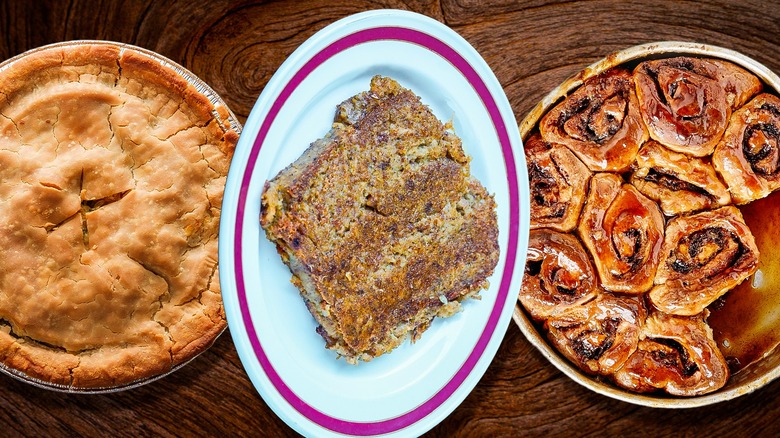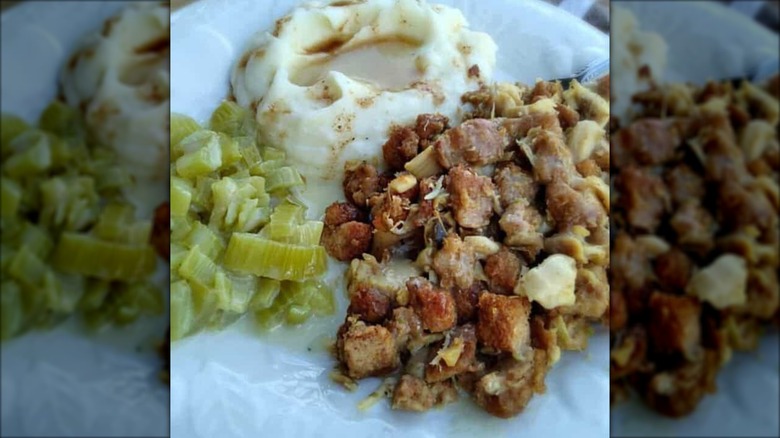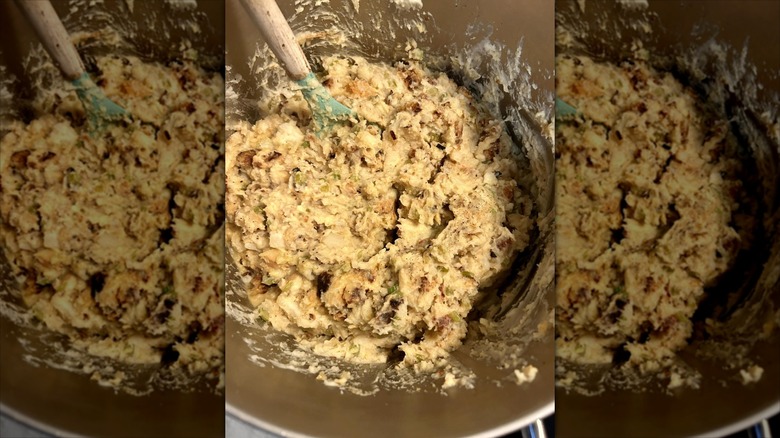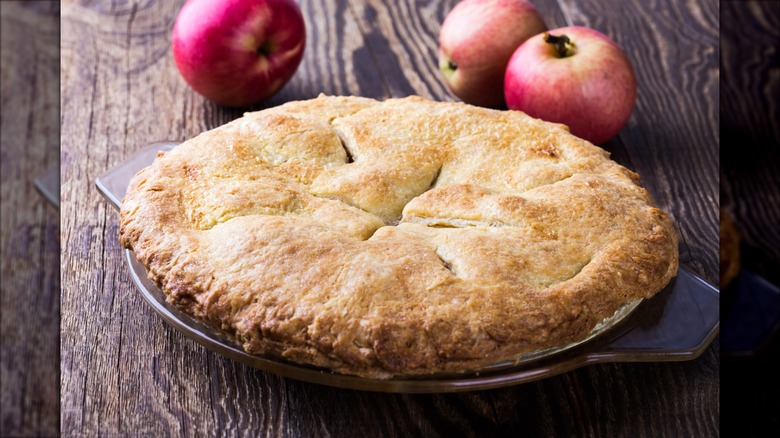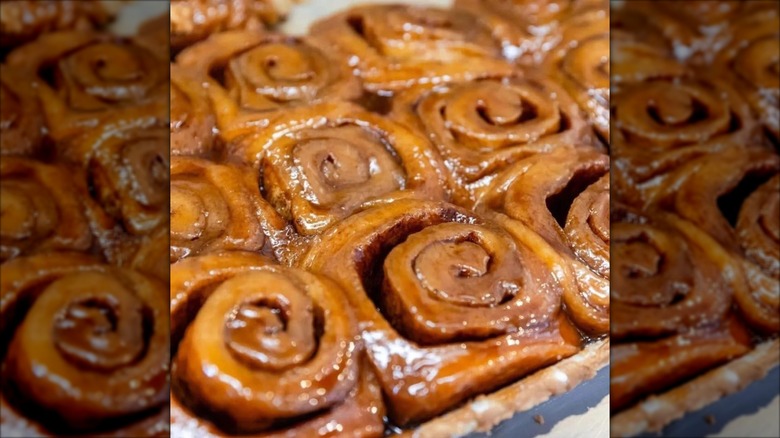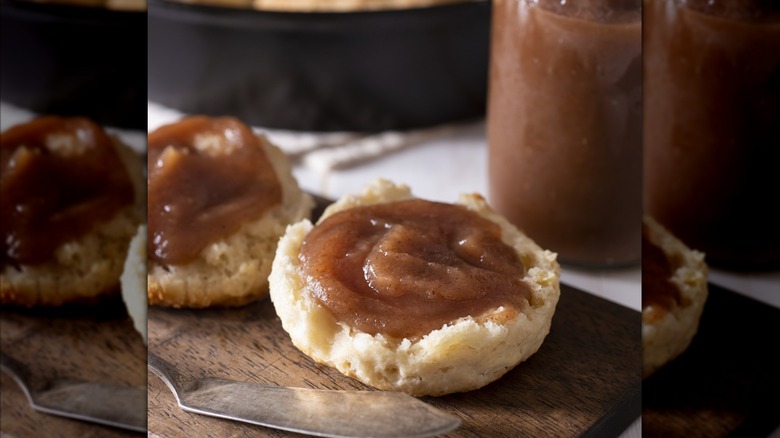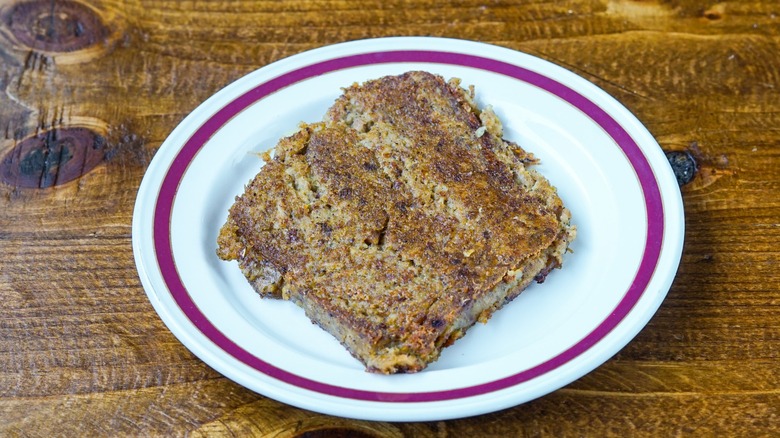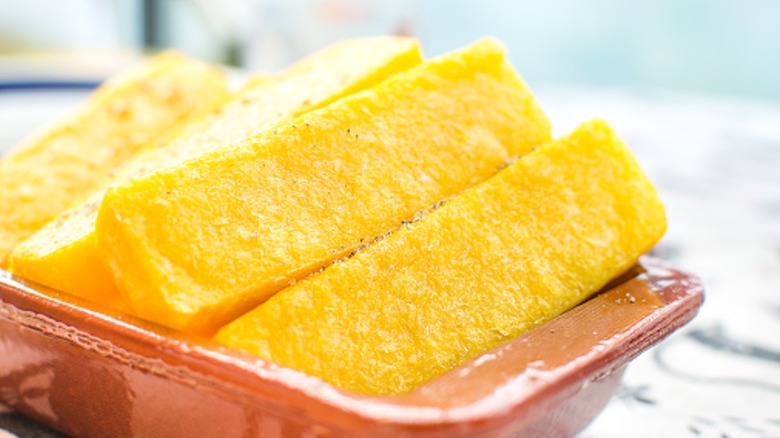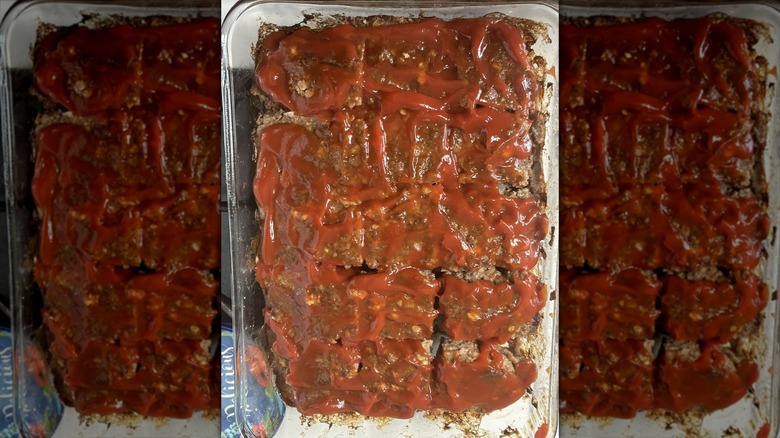13 Amish Foods You Need To Try
If you've ever stepped into authentic Amish country, you'll know that there are plenty of culinary treats on offer. Think fresh bread cooling on the counter, sweet pies tucked on countertops to cool, and long tables groaning under platters of meat and potatoes. Amish recipes may not all look exactly the same, as one household varies in preferences from another, but certain dishes are widely cherished, with the rhythm of the seasons often dictating the menu.
The Amish way of cooking has always been a practical, no-frills affair. Some dishes turn surplus fruit into winter staples, while others make use of scraps or stretch ingredients across big families. Yet do not be duped into assuming practical means dull. These dishes are chock full of comfort and filled with old-fashioned flavor. On your next visit, as you wander through Amish country, you'll be sure to find many of these items awaiting you at roadside stands, farmers' markets, or on the tables of families who've been making them for generations.
Amish wedding roast
No Amish wedding feels truly complete without a specific Amish roast (or roasht), particularly in Lancaster County. This traditional chicken or turkey roast — which is removed from the bones — is sliced into smaller pieces and baked together with buttery bread stuffing, is usually served alongside a mountain of mashed potatoes, a generous helping of creamed celery, and other sides that turn the celebratory meal into a full-on feast.
The dish carries a deep sense of tradition. Weddings in Amish communities aren't small affairs, with some even drawing hundreds of guests. Serving this dish is not just about feasting with great flavor. This roasht represents the community spirit of Amish life, where everyone works together to make sure the bride and groom are celebrated properly. The roasht is a milestone meal reserved for one of life's most meaningful occasions, as well as celebrations such as Thanksgiving or Christmas. Tasting it means tasting a piece of Amish history.
Pennsylvania Dutch potato filling
Somewhere between mashed potatoes and stuffing lies Pennsylvania Dutch potato filling, a starchy side that's pure comfort food. It starts with creamy mashed potatoes, but instead of stopping there, Amish cooks fold in cubed bread sautéed in butter, with celery, parsley, and onions (some add milk, but recipes do vary among households). The whole mix is baked until the top is crisp, leaving a golden crust.
Its history is tied to tough times. During the Great Depression, combining bread with potatoes stretched ingredients and made meals more filling. Families and the community could feed themselves without spending much, and the dish became a staple. You'll most often see it at holidays, especially Thanksgiving, baked in big pans alongside turkey or ham.
In Amish communities, it's also a go-to dish for other gatherings. Pennsylvania Dutch potato filling is cozy, satisfying, and always brings a sense of nostalgia. Families often put their own spin on the dish — some like more bread for a firmer filling, others go heavy on the potatoes for creaminess. But no matter the ratio, potato filling is one of those dishes that just belong at the center of the table.
Apple schnitz pie
If you grew up eating traditional apple pie, Amish schnitz pie (sometimes known as snitz pie) might surprise or even shock you. Instead of using fresh apples, it relies on dried apples, rehydrated and simmered with spices until they become a thick, applesauce-like filling. That filling gets tucked into a flaky crust, creating a dessert that's somehow both familiar and totally unique.
You might be wondering: Why dried apples? Before refrigeration, drying was a helpful method to preserve the orchard harvest through the harsh, cold seasons. Then, come fall and winter, schnitz pie was how those apples made their way back to the table. The pie is especially tied to Sunday gatherings and church suppers. In a world of fresh year-round produce, schnitz pie still carries that old rhythm of the seasons sentiment. If you find one at a roadside stand or Amish bakery, grab a slice, then savor this sweet echo of how resourcefulness and tradition shaped Amish kitchens.
Amish friendship bread
Amish friendship bread's appeal has just as much to do with the loaf as it does with the story behind it. The recipe begins with a starter, a fermented mixture of yeast, flour, sugar, and milk. While some of this is baked into bread, the starter is also shared among friends and neighbors.
The bread itself is sweet and often flavored with cinnamon sugar, but it is the meaning behind the doughy delicacy that is really significant. Each starter is a chain that connects households. You give some away, they bake and share again, and the cycle continues. The symbolism is strong. It's a sweet reflection of the Amish emphasis on community, generosity, and shared traditions, where a single bowl of batter becomes dozens of loaves and connections.
Some families add nuts, raisins, or apples. Others keep it plain, but every loaf carries the history of where its starter came from. So, if someone ever hands you a bag of bubbling starter, embrace it. You're stepping into a tradition that has circled through Amish kitchens for decades. And once you pull a warm loaf from the oven, you'll understand why it's worth keeping the cycle alive.
Amish sticky buns
At first glance, Amish sticky buns look a bit like your average cinnamon roll, but you'll soon realize they're in a league of their own. The dough is rolled with cinnamon-sugar, placed over a base of caramel glaze and pecans (some skip the nuts), and baked until golden. When the pan is inverted, every roll is coated in gooey caramel that drips down the swirls.
The origin traces back to German immigrants who brought spiral pastries baked with nuts and syrup, known as schnecken, to the U.S. When the Pennsylvania Dutch settled in the region, they adapted the recipe with what they had, creating today's Amish sticky buns.
Unlike frosted cinnamon rolls, Amish sticky buns don't need icing (some will add icing on top, but these buns traditionally go naked). This is because the glaze does the work, soaking into the dough while leaving the outside chewy and rich. You'll find these gooey treasures everywhere in Amish country, from Amish farmers' markets to breakfast tables, and even packaged for sale at roadside stands. If you ever want a true taste of Pennsylvania Dutch baking, skip the cinnamon rolls you know and reach for these sticky buns instead. They're Amish comfort food at its most indulgent.
Yumasetti (Amish noodle casserole)
Many households have go-to casseroles, and for the Amish, it's yumasetti. This one-dish wonder combines noodles, ground beef, and a creamy sauce (with some also topping it with a layer of bread cubes or crumbs), all baked to golden perfection. What makes yumasetti special is its adaptability. Some families sneak in peas, carrots, corn, or more, while others stick to simply noodles, beef, and sauce.
It's comfort food through and through, a hearty, practical, and tasty meal designed to feed large families without fuss. For outsiders, yumasetti might resemble any old noodle bake, but for Amish families, it's a comfort dish that warms you up and stretches ingredients to last. If you ever get the chance, don't pass on yumasetti. It's the kind of food that doesn't just fill your stomach, but also fills your heart.
Apple butter or peach butter
Few spreads are as tied to Amish tradition as apple butter. Unlike regular butter, it's actually a slow-cooked fruit preserve made by simmering apples until they caramelize into a dark, spiced paste. The process traces back to European settlers, who brought the practice to Pennsylvania, where the Amish and Pennsylvania Dutch turned it into a gathering ritual.
Communities once hosted schnitzing parties, where families gathered to stir big kettles over open fires, fellowshipping as the fruit thickened. These gatherings weren't just about preserving the harvest, but were highly anticipated social events that brought people together. Peach butter followed the same concept, using orchard fruit to make a spread that could last through winter.
Today, you'll find these fruit butters slathered on toast, spooned into oatmeal, or even served with meats. Each bite of this Amish butter magic is a mirror of centuries of tradition, simmered down to sweet perfection.
Scrapple
Scrapple is one of those dishes that can divide a room. The name leaves no mystery – scrapple does, indeed, come from scraps. Born out of necessity, it ensured that no part of the pig went to waste. In Amish kitchens, a place where thriftiness and respect for limited resources come first, that philosophy still stands. Made by simmering pork offcuts with cornmeal or buckwheat flour into a loaf, then slicing and pan-frying, scrapple is crispy on the outside and tender on the inside.
At breakfast, scrapple often sits beside the likes of eggs and toast. Some drizzle it with syrup, others eat it savory with ketchup. While visitors might hesitate at the idea of eating pork scraps, one bite usually changes minds. Think of it as a cross between sausage and cornbread, with a texture that's hearty, satisfying, and comparable to a softer version of your standard pork breakfast sausage. For anyone exploring Amish country, trying scrapple is practically a rite of passage. You might love it, you might not, but you'll definitely remember your first forkful.
Fried Amish corn meal mush
Amish fried cornmeal mush is proof that simplicity can be delicious. To make it, cooks boil cornmeal, water, and salt into a porridge, pour it into a pan, and let it chill overnight until firm. The next morning, they slice it and fry it in butter until crisp. On the plate, Amish fried cornmeal mush looks like little golden cakes that are crispy on the outside and soft inside. Toppings vary. Maple syrup makes it sweet, while ketchup or savory sides give it a more hearty bend. Either way, it's a breakfast that fills you up without fuss.
Historically, mush was a budget-friendly way to stretch cornmeal, which was cheap and plentiful in Pennsylvania. Today, it's still popular in Amish homes, but also found on the menu at diners and markets throughout the region. Think of it as the Pennsylvania Dutch cousin to Italian polenta cakes (same concept, different tradition). If you like comfort foods that are crispy, warm, and endlessly adaptable, fried mush deserves a spot on your breakfast plate.
Amish peanut butter spread
Amish church services typically end with food, and one of the most beloved staples on the table is peanut butter spread whipped with marshmallow fluff and molasses. If you've ever had a fluffernutter sandwich, you'll get the idea. The spread is sweet, fluffy, and surprisingly versatile. It's even earned a seat as a resident condiment on the table of many local eateries, making it as nearly essential as salt and pepper (which it fittingly sits alongside just waiting to bless your restaurant bites with signature Amish country flair.
Part of the appeal is tradition. In Amish communities, sharing a simple meal after church is all about connection, and this peanut butter spread ties those gatherings together, linking generations with each sweet bite. Amish peanut butter spread is equally nostalgic, tied not just to novelty but to an Amish weekly ritual. For anyone visiting Amish country, it's one of the easiest and tastiest ways to experience the culture.
Coffee soup
At first mention, coffee soup may sound like an unexpected creation, but for many in the Amish community, it's a nostalgic breakfast from childhood. The recipe is simple. Freshly brewed coffee is poured over pieces of ripped-up bread, with sugar and cream added to taste. Each person is free to, and does, customize it as they please. Some people make it with saltine crackers instead of bread. Some like it sweeter, while others add more coffee for bitterness. The bread or crackers soften into the warm liquid after it's poured over them, creating a texture that's best described as being part soup, part cereal.
Coffee soup reflects Amish practicality. It's inexpensive, filling, and easy to make, especially on busy mornings before chores. Parents could whip it up quickly, and kids often grew up loving it. It's not flashy, but it's beloved. For many Amish adults, coffee soup is tied to warm memories of kitchen tables crowded with siblings. It shows how even the simplest foods can carry meaning when shared.
Amish meatloaf with oats
When it comes to weeknight dinners, Amish meatloaf stands out for one key twist: rolled oats replace breadcrumbs as a binder, and tomato juice keeps the loaf moist and tender. This swap not only makes the dish heartier, but it also reflects values of practicality and efficiency, with oats being affordable, plentiful, and practical. The result is a meatloaf that's tender, flavorful, and satisfying.
Often served with mashed potatoes, vegetables, or noodles, with leftovers sometimes used in sandwiches, Amish meatloaf is a staple of Amish home cooking. The dish appears on tables as a reliable comfort dish that you can whip up relatively quickly. As with plenty of dishes, the exact recipe for Amish meatloaf can differ from home to home. Some cooks add onions or peppers, others add the likes of bacon, while there are also those who shape the loaf differently. The list goes on. But the core idea — oats instead of breadcrumbs — remains consistent, showing how tradition adapts to fit what the pantry holds. If you think meatloaf is boring, Amish-style meatloaf may just change your mind.
Meadow tea
Imagine Southern sweet tea, but swap the tea leaves for fresh mint picked straight from the garden. That's meadow tea, a refreshing Amish favorite sometimes known as garden tea. The mint leaves (which are typically spearmint, peppermint, or a combination of the two) are boiled, steeped, strained, and cooled, then poured over ice and sweetened to taste for a mouthwatering, minty drink.
Meadow tea is especially popular in summer. Its charm lies in its simplicity: mint is natural, it grows abundantly, and the recipe requires little more than boiling water and enough sugar or sweetener to suit. It also happens to be naturally caffeine-free, serves as a helpful digestion aid, and smells divine. One can imagine adults sipping the tea on afternoons in the garden, with kids grabbing glasses between games of play. For many, it was, and remains, a detail that signals the arrival of summer and makes the season feel complete.
